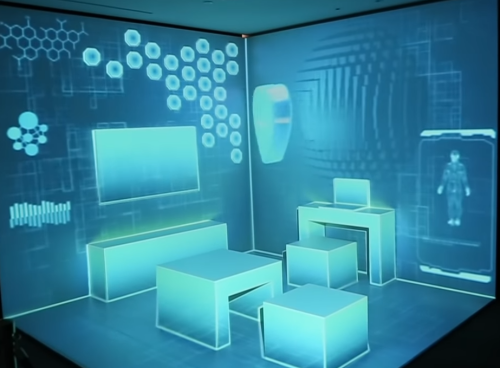3D projection mapping on architectural scale models is revolutionizing the way architectural designs are presented in Dubai. Known for its futuristic skyline and groundbreaking developments, Dubai is a hub of innovation where cutting-edge visualization techniques help bring ambitious architectural concepts to life.
1. Understanding 3D Projection Mapping on Architectural Scale Models
What Is 3D Projection Mapping?
3D projection mapping is a visual technology that projects digital images, videos, or animations onto physical objects or surfaces, enhancing them with dynamic content. When applied to architectural scale models, this technique allows for real-time visualization of design elements, making the models more interactive and informative.
How Does It Work for Interior Spaces?
For interior visualization, 3D projection mapping overlays detailed, high-resolution projections onto an architectural scale model, simulating furniture layouts, lighting designs, textures, and interior decorations. Advanced projection techniques even allow room-by-room visual transitions, enabling viewers to explore different parts of a building without physically altering the model.
2. The Benefits of Using 3D Projection Mapping for Interior Visualization
A. Realistic Representation of Interior Designs
Traditional scale models often lack detailed interiors, but with 3D projection mapping, developers and architects can display:
- Furniture arrangements
- Wall textures and color schemes
- Flooring materials and patterns
- Lighting effects (day/night settings)
- Ceiling designs and structural elements
B. Cost-Effective Alternative to Physical Interior Models
Building detailed physical interior models for large-scale projects can be costly. 3D projection mapping eliminates the need for multiple model variations, as digital content can be modified in real time, reducing production costs.
C. Interactive and Customizable Presentations
Clients, investors, and stakeholders can interact with projected interiors, choosing different layouts, colors, and furniture designs to see how various configurations will look before finalizing decisions.
D. Seamless Integration with Smart Home Technologies
Developers in Dubai’s luxury real estate sector are integrating smart home automation into their projects. 3D projection mapping can simulate smart features such as:
- Automated lighting adjustments
- Motorized blinds and curtains
- Smart kitchen setups
- AI-driven home assistants
E. Enhanced Client Engagement
For real estate sales and project presentations, a dynamic, visually appealing interior simulation creates a more immersive and persuasive experience, leading to faster decision-making and higher sales conversion rates.
3. Applications of 3D Projection Mapping for Interior Spaces in Dubai
A. Luxury Real Estate Developments
Dubai’s high-end residential and commercial projects benefit significantly from 3D projection mapping. Developers use this technology to:
- Showcase penthouse interiors before actual construction
- Provide interactive villa design previews
- Help investors visualize furnished and unfurnished spaces
- Demonstrate luxury hotel suites with variable interior settings
B. Hospitality and Tourism Sector
Dubai’s booming hospitality industry leverages 3D projection mapping for:
- Hotel room previews in new resorts
- Theme park interior walkthroughs (e.g., hotel lobbies, entertainment areas)
- Event space transformations in venues like Dubai Opera or Expo City Dubai
C. Commercial and Retail Space Planning
Retail brands and shopping malls use 3D projection mapping on architectural scale models Dubai to:
- Visualize storefront layouts before physical setup
- Test different interior configurations for flagship stores
- Enhance shopping mall planning (e.g., optimizing foot traffic flow)
D. Healthcare Facility Planning
Hospitals and medical centers use 3D projection mapping to simulate:
- Patient room designs and configurations
- Emergency room layouts for optimized workflows
- Medical equipment placement for efficiency
E. Educational Institutions and Research Facilities
Dubai’s universities and research centers use 3D projection mapping to visualize:
- Campus interior layouts (e.g., lecture halls, libraries, labs)
- Virtual museum exhibits in cultural institutions
- Scientific research projects that require interior structural analysis
F. Film and Entertainment Industry
Dubai’s film studios and entertainment venues utilize 3D projection mapping to:
- Create immersive virtual film sets
- Simulate lighting and camera setups for productions
- Design futuristic stage environments for live performances
4. The Future of Interior Visualization with 3D Projection Mapping in Dubai
A. Integration with Augmented and Virtual Reality
Dubai is at the forefront of VR and AR innovations. In the future, 3D projection mapping on architectural scale models could integrate with AR/VR technologies, allowing viewers to walk through projected interiors using mixed reality devices.
B. AI-Driven Adaptive Interior Designs
AI-powered algorithms could analyze user preferences and automatically generate personalized interior designs via 3D projection mapping, offering:
- AI-curated furniture placements
- Smart recommendations based on lighting and space constraints
- Dynamic mood-based interior adjustments
C. Sustainable Design Simulations
With Dubai’s growing focus on sustainability, 3D projection mapping can visualize eco-friendly interiors, such as:
- Energy-efficient lighting solutions
- Sustainable building materials and interior finishes
- Smart climate control systems integrated into living spaces
D. Multi-Sensory Projection Mapping
Future advancements in haptic feedback, sound integration, and scent-based projection mapping could create multi-sensory interior experiences, enhancing architectural presentations.
5. Challenges and Considerations for 3D Projection Mapping in Interior Spaces
A. Precision and Scale Limitations
While 3D projection mapping is highly detailed, scaling down intricate interior elements like furniture textures and fixtures may require high-resolution projection systems and advanced software.
B. Projection Accuracy in Complex Layouts
Interiors with curved surfaces, varying heights, and reflective materials can pose challenges in projection mapping. Advanced calibration techniques are needed to maintain visual clarity.
C. Cost of Implementation
High-quality 3D projection mapping requires specialized hardware, software, and expert technical teams, making it a significant investment for developers.
D. Limited Real-Time Interactivity
While digital projections allow for some interactivity, true real-time manipulation (e.g., physically moving projected objects within a model) still requires integration with AR/VR technology.
Final Thoughts
3D projection mapping on architectural scale models in Dubai can effectively visualize interior spaces, offering unparalleled realism, customization, and interactive experiences. This technology is transforming real estate, hospitality, retail, healthcare, education, and entertainment industries, enhancing architectural presentations and client engagement.
As Dubai continues to innovate, the future of 3D projection mapping in interior visualization will expand further, integrating AI, AR/VR, and sustainability-driven designs. Developers, architects, and investors who adopt this cutting-edge technology will gain a competitive advantage, making architectural visualization more immersive and dynamic than ever before.

